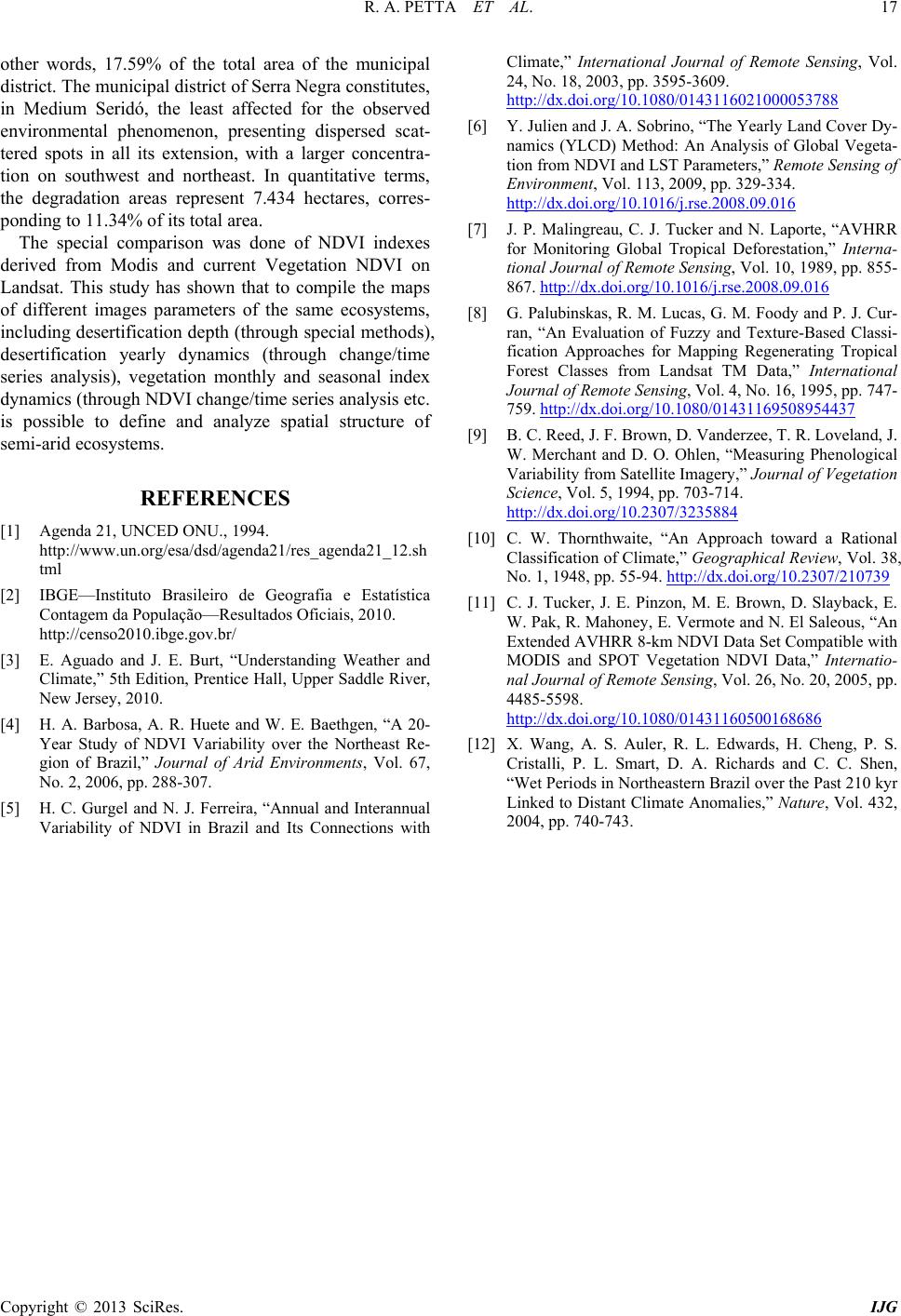
R. A. PETTA ET AL.
Copyright © 2013 SciRes. IJG
other words, 17.59% of the total area of the municipal
district. The municipal district of Serra Negra constitutes,
in Medium Seridó, the least affected for the observed
environmental phenomenon, presenting dispersed scat-
tered spots in all its extension, with a larger concentra-
tion on southwest and northeast. In quantitative terms,
the degradation areas represent 7.434 hectares, corres-
ponding to 11.34% of its total area.
The special comparison was done of NDVI indexes
derived from Modis and current Vegetation NDVI on
Landsat. This study has shown that to compile the maps
of different images parameters of the same ecosystems,
including desertification depth (through special methods),
desertification yearly dynamics (through change/time
series analysis), vegetation monthly and seasonal index
dynamics (through NDVI change/time series analysis etc.
is possible to define and analyze spatial structure of
semi-arid ecosystems.
REFERENCES
[1] Agenda 21, UNCED ONU., 1994.
http://www.un.org/esa/dsd/agenda21/res_agenda21_12.sh
tml
[2] IBGE—Instituto Brasileiro de Geografia e Estatística
Contagem da População—Resultados Oficiais, 2010.
http://censo2010.ibge.gov.br/
[3] E. Aguado and J. E. Burt, “Understanding Weather and
Climate,” 5th Edition, Prentice Hall, Upper Saddle River,
New Jersey, 2010.
[4] H. A. Barbosa, A. R. Huete and W. E. Baethgen, “A 20-
Year Study of NDVI Variability over the Northeast Re-
gion of Brazil,” Journal of Arid Environments, Vol. 67,
No. 2, 2006, pp. 288-307.
[5] H. C. Gurgel and N. J. Ferreira, “Annual and Interannual
Variability of NDVI in Brazil and Its Connections with
Climate,” International Journal of Remote Sensing, Vol.
24, No. 18, 2003, pp. 3595-3609.
http://dx.doi.org/10.1080/0143116021000053788
[6] Y. Julien and J. A. Sobrino, “The Yearly Land Cover Dy-
namics (YLCD) Method: An Analysis of Global Vegeta-
tion from NDVI and LST Parameters,” Remote Sensing of
Environment, Vol. 113, 2009, pp. 329-334.
http://dx.doi.org/10.1016/j.rse.2008.09.016
[7] J. P. Malingreau, C. J. Tucker and N. Laporte, “AVHRR
for Monitoring Global Tropical Deforestation,” Interna-
tional Journal of Remote Sensing, Vol. 10, 1989, pp. 855-
867. http://dx.doi.org/10.1016/j.rse.2008.09.016
[8] G. Palubinskas, R. M. Lucas, G. M. Foody and P. J. Cur-
ran, “An Evaluation of Fuzzy and Texture-Based Classi-
fication Approaches for Mapping Regenerating Tropical
Forest Classes from Landsat TM Data,” International
Journal of Remote Sensing, Vol. 4, No. 16, 1995, pp. 747-
759. http://dx.doi.org/10.1080/01431169508954437
[9] B. C. Reed, J. F. Brown, D. Vanderzee, T. R. Loveland, J.
W. Merchant and D. O. Ohlen, “Measuring Phenological
Variability from Satellite Imagery,” Journal of Vegetation
Science, Vol. 5, 1994, pp. 703-714.
http://dx.doi.org/10.2307/3235884
[10] C. W. Thornthwaite, “An Approach toward a Rational
Classification of Climate,” Geographical Review, Vol. 38,
No. 1, 1948, pp. 55-94. http://dx.doi.org/10.2307/210739
[11] C. J. Tucker, J. E. Pinzon, M. E. Brown, D. Slayback, E.
W. Pak, R. Mahoney , E. Vermote and N. El Saleous, “An
Extended AVHRR 8-km NDVI Data Se t Compa ti ble wit h
MODIS and SPOT Vegetation NDVI Data,” Internatio-
nal Journal of Remote Sensing, Vol. 26, No. 20, 2005, pp.
4485-5598.
http://dx.doi.org/10.1080/01431160500168686
[12] X. Wang, A. S. Auler, R. L. Edwards, H. Cheng, P. S.
Cristalli, P. L. Smart, D. A. Richards and C. C. Shen,
“Wet Periods in Northeastern Brazil ove r the Past 210 kyr
Linked to Distant Climate Anomalies,” Nature, Vol. 432,
2004, pp. 740-743.